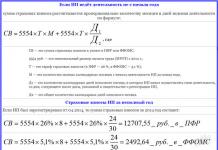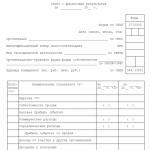Due to the difficult financial situation in the country, cases have become more frequent when parties to contracts (supply, contract, provision of services, lease) indicate the price in conventional units.
This possibility is provided for in paragraph 2 of Article 317 of the Civil Code of the Russian Federation.
However, this does not mean that the buyer will have to pay for the goods in conventional units. Calculations will be made “in rubles in an amount equivalent to a certain amount... in conventional monetary units” (Clause 2 of Article 317 of the Civil Code of the Russian Federation).
As a rule, suppliers (performers, contractors, lessors) are interested in using conventional units, as this allows them to eliminate the negative impact of inflation and rising exchange rates on the amount of payments.
Rationale: The opportunity to determine prices in conventional units appeared in connection with rapid inflation, which especially increased in the first half of the 90s of the last century.
It was economically extremely unprofitable for the party that was supposed to receive money in payment (supplier, performer, contractor, lessor) to determine the price of the contract (especially long-term) in rubles.
If the legislator had provided for the possibility of expressing obligations exclusively in rubles, this could have had negative consequences for turnover and the creation of schemes to circumvent these requirements.
At the same time, for the buyer (customer, tenant) this means that the main financial risks (for example, in the event of a fall in the ruble exchange rate) will fall on him - there is a high probability of paying O a larger amount than planned. In addition, in case of “miscalculations” with the wording, there is a risk that the contract will be declared unconcluded or the price condition will be invalid. This means that if the course of action is unsuccessful for an unscrupulous counterparty, he will be able to refer to this circumstance and refuse to fulfill his obligations.
Conventional units in the understanding of the Civil Code of the Russian Federation
From the point of view of the Civil Code of the Russian Federation, conventional units are not at all . In business agreements, the parties use the concept of “conventional units” to link either to the exchange rate of any foreign currency (when conventional units are actually equal to foreign currency), or to a specific amount in rubles (like “conventional units = 50 rubles”) ."). In such cases, the conventional unit actually loses its content and turns into a kind of multiplier.
The Civil Code of the Russian Federation names conventional monetary units on a par with foreign currency and does not identify these concepts: “A monetary obligation may stipulate that it is payable in rubles in an amount equivalent to a certain amount in foreign currency or in conventional monetary units..." (clause 2 of article 317 of the Civil Code of the Russian Federation).
That is, the same obligation cannot be simultaneously expressed in foreign currency and in conventional units. These are alternative units. This is directly indicated by paragraph 2 of Article 317 of the Civil Code of the Russian Federation, both grammatically and logically.
The concept of foreign currency is given in paragraph 2 of part 1 of article 1 of the Federal Law of December 10, 2003 No. 173-FZ “On Currency Regulation and Currency Control” (hereinafter referred to as Law No. 173-FZ). This:
- “banknotes in the form of banknotes, treasury notes, coins that are in circulation and are a legal means of cash payment on the territory of the relevant foreign state (group of foreign states), as well as these banknotes that are withdrawn or withdrawn from circulation but subject to exchange;
- funds in bank accounts and bank deposits in monetary units of foreign countries and international monetary or settlement units.”
Within the meaning of paragraph 1 of Article 140 of the Civil Code of the Russian Federation, currency is a legal means of payment, that is, mandatory for acceptance in the relevant state. This norm identifies the concepts of “currency” and “money”. Accordingly, foreign currency is a legal tender issued by a foreign state.
A conventional monetary unit is a means of payment that is not a legal means of payment, but allows the calculation of the monetary obligations of the parties if they agree on it.
The Civil Code of the Russian Federation gives two examples of conventional units.
1. ECU (European Currency Unit)
This is a European unit of account that was used from 1979-1998. It was used in the European Monetary System, in particular by the European Monetary Cooperation Fund. The ECU rate was formed as something average from a set of 8-12 European banknotes. It was determined daily, since the exchange rate of the currencies included in the basket changed daily.
The ECU did not have a material form in the form of banknotes or coins and was not used in payments in the consumer market.
In 1999, the ecu was replaced by the euro (now a real currency).
2. Special Drawing Rights
It is a conventional unit of account used by member countries of the International Monetary Fund (IMF) to provide loans since 1969. Until 1981, it was determined on the basis of the weighted average value and changes in the exchange rate of the currencies included in the currency basket, which included the currencies of the United States, Germany, Great Britain, France and Japan. Today, the SDR is determined based on the dollar value of a basket of four leading currencies: the US dollar, euro, yen and pound sterling and is published daily on IMF website.
The SDR has only a non-cash form in the form of entries in bank accounts; banknotes have not been issued.
It is worth noting that neither the ECU nor the SDR is a currency.
As an example of another conventional unit, we can name the cost of the bi-currency basket of the Central Bank of the Russian Federation. This is the operational benchmark of the Bank of Russia's exchange rate policy expressed in national currency, consisting of the US dollar and the euro. Thus, the Twentieth Arbitration Court of Appeal considered a dispute arising from a purchase and sale agreement, in which the parties agreed that “at the time of conclusion of the agreement, the cost is 1 USD. e. is the cost of the bi-currency basket of the Central Bank of the Russian Federation, officially published in the media as of December 1, 2012” (resolution of March 26, 2014 in case No. A23-3562/2013).
Judging by the practice of using conventional monetary units in trade turnover in the sense of Article 317 of the Civil Code of the Russian Federation, this is absolutely exotic.
Conventional units in practice
Despite what is stated in the Civil Code of the Russian Federation , in practice these concepts are mixed.
Today, an obligation expressed in conventional units is an obligation expressed in a foreign currency (usually dollars or euros), but subject to execution in rubles.
Conventional monetary units have actually become a euphemism.
So, in practice, the parties include the following conditions in contracts:
- “for calculation purposes, one conventional unit is taken to be the ruble equivalent of one US dollar, calculated at the exchange rate of the Central Bank of the Russian Federation on the day of payment” (resolution of the Seventeenth Arbitration Court of Appeal dated August 5, 2014 No. 17AP-8003/2014-GK in case No. A60 -50101/2013) or “the conventional unit for this agreement is equivalent to one US dollar” (ruling of the Nineteenth Arbitration Court of Appeal dated May 19, 2014 in case No. A14-10175/2013);
- “prices for goods and the total cost of the supplied Goods are indicated in conventional units (cu). One conventional unit is equivalent to one euro (EUR) and is payable in Russian rubles at the euro (EUR) exchange rate established by the Central Bank of the Russian Federation on the date of payment” (resolution of the Nineteenth Arbitration Court of Appeal dated November 29, 2013 in case No. A35-4276/ 2013) or “one conventional unit is equal to one euro” (ruling of the Eleventh Arbitration Court of Appeal dated May 23, 2012 in case No. A65-30879/2011);
- “The tenant agreed to pay... an advance payment... at the rate of 30 rubles. for one conventional unit, which is equivalent to 216,540 rubles.” (resolution of the Thirteenth Arbitration Court of Appeal dated October 9, 2014 in case No. A56-5431/2014) or simply “one conventional unit is equal to 25 rubles” (resolution of the Federal Antimonopoly Service of the East Siberian District dated January 27, 2014 in case No. A78-8252 /2011, see also the decision of the Fifteenth Arbitration Court of Appeal dated May 29, 2014 No. 15AP-7732/2014 in case No. A32-2262/2014);
- “the amount of rent is set in conventional units (one conventional unit is equal to one US dollar) at the rate of 30 rubles. 00 kop. for one conventional unit" (resolution of the Federal Antimonopoly Service of the Moscow District dated June 7, 2011 No. KG-A40/5564-11 in case No. A40-44883\10-37-345) or "the exchange rate of a conventional monetary unit is equivalent to the US dollar exchange rate announced by the Bank Russia as of 09/01/1998 (9.33 rubles per US dollar)” (resolution of the Fourteenth Arbitration Court of Appeal dated January 26, 2012 in case No. A05-9363/2011).
The courts are quite loyal to such formulations.
Example from practice: the court collected a debt for goods supplied under an agreement in which the price of the goods was determined in conventional units
JSC "A." (supplier) and AP CJSC (buyer) entered into an agreement for the supply of equipment and an additional agreement to it, according to which the price of the goods is 427,158 USD. e., including VAT. The parties also determined that payment would be made “in rubles at the exchange rate of the Central Bank of the Russian Federation on the day the payment was made, 1 USD. e. equal to 1 US dollar.”
The buyer made an advance payment in the amount of RUB 6,644,955.28.
The supplier delivered the goods, but did not receive the remaining amount (213,579 cu or 6,877,350.58 rubles).
JSC "A." filed a claim with the arbitration court for the recovery of 6,877,350.58 rubles. principal debt and 709,226.78 rubles. percent.
The claims were satisfied in full (resolution of the Federal Antimonopoly Service of the Central District dated August 8, 2012 in case No. 14-10300/2011).
Rationale: In the early 90s, with galloping inflation, the terms of agreements on prices and settlements in US dollars were widely practiced.
However, on March 6, 1993, the Russian Government issued Decree No. 205 “On strengthening foreign exchange and export controls and on the development of the foreign exchange market.” Its paragraph 17 contained a recommendation to the Central Bank of the Russian Federation to take measures to “terminate settlements in foreign currency between residents on the territory of the Russian Federation.”
As a result, entrepreneurs simply replaced the word “dollar” with “u.” e." At the same time, the content of the conventional units did not change - the parties continued to make payments in dollars. The equality between conventional units and foreign currency was strengthened in consciousness.
This was facilitated by legislation on accounting and reporting, and clarifications from the Russian Ministry of Finance (for example, letters of the Russian Ministry of Finance dated May 15, 2009 No. 03-03-06/1/324 and No. 03-03-06/1/325).
In particular, the Ministry of Finance of Russia, in its letter dated April 2, 2009 No. 03-03-06/1/204, paraphrased paragraph 3 of the information letter of the Presidium of the Supreme Arbitration Court of the Russian Federation dated November 4, 2002 No. 70 “On the application by arbitration courts of Articles 140 and 317 Civil Code of the Russian Federation" (hereinafter referred to as information letter No. 70): "... in the case where in the contract a monetary obligation is expressed in foreign currency without indicating its payment in rubles, such a contractual condition should be considered as provided for in paragraph 2 of Art. 317 of the Civil Code of the Russian Federation, that is, as an obligation expressed in conventional units... Thus, a monetary obligation expressed in foreign currency, if such an obligation according to the contract or based on the essence of the transaction is payable in Russian rubles, should be considered as an obligation, expressed in conventional units."
Conventional units in the text of the contract
In order to agree on the use of conventional units in the text of the contract, it is necessary to define:
1) Conventional unit (to what type of foreign currency is the conventional monetary unit equated). For more information about what is meant by conventional units, see And .
Examples of the wording of the terms of the contract about what the parties understand by conventional monetary units
1. “One conventional unit is equal to the value of the bi-currency basket of the Central Bank of the Russian Federation.”
2. “The conventional unit for this agreement is equivalent to one US dollar.”
3. “One conventional unit is equivalent to one euro.”
4. “One conventional unit is equal to one Chinese yuan” (resolution of the Ninth Arbitration Court of Appeal dated October 23, 2013 No. 09AP-26396/2013-GK, 09AP-27091/2013-GK in case No. A40-173111/12).
5. “One conventional unit is equal to 30 rubles. In the event that the US dollar exchange rate established by the Central Bank of the Russian Federation on the date of payment exceeds 30 rubles, one conventional unit is equal to one US dollar” (resolution of the Fifteenth Arbitration Court of Appeal dated May 29, 2014 No. 15AP-7732/2014 in case No. A32 -2262/2014).
6. “One conventional unit under the agreement is equal to an amount in rubles of the Russian Federation, equivalent to 1 (one) US dollar at the rate determined by the Central Bank of the Russian Federation (hereinafter referred to as the official rate) on the date of payment of at least 30 rubles. If the official exchange rate of the US dollar against the ruble decreases below the level of 30 rubles per one US dollar, the parties, from the moment of such reduction and until the date the official dollar exchange rate exceeds the mark of 30 rubles per one US dollar, consider that the conventional unit is equal to thirty rubles" ( resolution of the First Arbitration Court of Appeal dated September 23, 2014 in case No. A43-1151/2014).
7. “One conventional unit is equal to the exchange rate of the US dollar against the ruble established by the Central Bank on the day of issuing the invoice minus 3 (Three) rubles, but in the end no less than 31 rubles and no more than 37 rubles” (resolution of the Ninth Arbitration Court of Appeal dated August 28 2014 No. 09AP-30492/2014-GK in case No. A40-27875/2014).
8. “One conventional unit is equal to the arithmetic mean between the US dollar exchange rate in relation to the ruble and the euro exchange rate in relation to the ruble, established by the Bank of Russia on the day of payment” (resolution of the Federal Antimonopoly Service of the North Caucasus District dated March 15, 2012 in case No. A32- 13741/2011, Fifteenth Arbitration Court of Appeal dated June 21, 2013 No. 15AP-5746/2013 in case No. A53-28751/2012).
9. “One conventional unit is equal to 0.5 US dollar plus 0.5 euro” (resolution of the Seventeenth Arbitration Court of Appeal dated March 17, 2011 No. 17AP-1692/2011-AK in case No. A50-20354/2010).
If the parties do not indicate, which is a conventional unit in the context of the contract, then the price condition will not be considered agreed upon. Thus, in the case of a real estate lease agreement, for which the rental payment condition is essential, this will indicate that the agreement has not been concluded (clause 1 of Article 654 of the Civil Code of the Russian Federation, see Rent).
For a supply agreement (contract, provision of services), non-agreement on the price of goods may entail the following:
- it will be determined by the price which, under comparable circumstances, would normally be charged for like goods, or
- the contract will be recognized as not concluded.
2) Condition for payment of a monetary obligation in rubles. The Civil Code of the Russian Federation sets the corresponding condition in paragraph 2 of Article 317 of the Civil Code of the Russian Federation.
An example of the wording of the terms of a supply agreement with the price of goods in conventional units about payment in rubles
“The goods are subject to payment in rubles in an amount equivalent to the amount specified in paragraph ____ of this agreement.”
If the parties do not indicate If payment of a monetary obligation is made in rubles, then three scenarios are possible.
First option. The customer (buyer, lessee) will be able to pay a fee in foreign currency if the obligation relates to a case where the law allows the use of foreign currency as a means of payment on the territory of the Russian Federation (clause 2 of Article 140 and clause 3 of Article 317 of the Civil Code of the Russian Federation) . Thus, settlements using foreign currency between the parties to a supply agreement are allowed under foreign trade agreements in which one of the parties is a foreign person - a non-resident (Articles 6, 9 of Law No. 173-FZ). An exhaustive list of permitted currency transactions for residents is established in Article 9 of Law No. 173-FZ. All other currency transactions between residents are prohibited.
Second option. The customer (buyer, lessee) will be required to pay in rubles:
- if, when interpreting the agreement according to the rules of Article 431 of the Civil Code of the Russian Federation, the court does not come to the conclusion that the parties planned to make payment in foreign currency;
- if, due to the rules of currency legislation, this obligation cannot be fulfilled in foreign currency;
- if, when interpreting the contract in accordance with the rules of Article 431 of the Civil Code of the Russian Federation, the court comes to the conclusion that the parties planned to make payment in foreign currency.
However, recognizing the payment condition as invalid does not entail invalidating the contract if it can be assumed that the contract would have been concluded without this condition (Article 180 of the Civil Code of the Russian Federation, clause 3 of Information Letter No. 70).
3) Rate of conventional monetary units. So, in the contract you can stipulate the use of:
- official exchange rate of the Bank of Russia;
- exchange rate determined by a foreign exchange exchange (for example, Moscow Exchange , St. Petersburg Currency Exchange , Siberian Interbank Currency Exchange and others; these courses are published in the Izvestia newspaper);
- foreign currency exchange rate determined according to the scheme fixed in the agreement (for example, the agreement may stipulate that the Bank of Russia exchange rate increased by a certain percentage is used for conversion);
- a different ratio of foreign currency and the ruble.
An example of the wording of the terms of an agreement on the exchange rate of conventional monetary units
1. “One conventional unit is payable at the rate of the Central Bank of the Russian Federation.”
2. “One conventional unit is payable at the Moscow Exchange exchange rate.”
3. “One conventional unit is subject to payment at the rate of the Central Bank of the Russian Federation, but not less than 27 rubles per conventional unit.”
4. “One conventional unit is subject to payment at the rate of the Central Bank of the Russian Federation, but not less than 30 rubles per one conventional unit and not more than 34 rubles per one conventional unit.”
5. “One conventional unit is payable at the rate of the Central Bank of the Russian Federation plus 3%.”
It is worth noting that the parties can establish:
- own rate of conversion of conventional monetary units into rubles or
- the procedure for determining such a course.
This was indicated by the Presidium of the Supreme Arbitration Court of the Russian Federation in paragraph 2 of paragraph 12 of information letter No. 70.
An example of the wording of the terms of a lease agreement on its own conversion rate of conventional monetary units
“The rent is calculated in the following order: the rent indicated in conventional units is multiplied by 1.18 (VAT amount equal to 18%) and by 25 rubles” (resolution of the Arbitration Court of the Moscow District dated August 18, 2014 No. F05-8720 /2014 in case No. A40-52760/13-85-515).
Attention!If the parties have agreed that payment is made not at the Bank of Russia rate, but at another rate to be determined, then the parties should have the opportunity to obtain evidence of its existence and (or) the procedure for determining its amount.
Otherwise, the court will apply the Bank of Russia rate. This means that the buyer (customer, tenant) will not pay the amount that he was guided by when concluding the contract: it can be either less or more. For example, the parties may agree that by conventional unit they mean the US dollar, the rate of which is determined by an additional agreement. If, in the event of a dispute, such an additional agreement is not submitted to the court, then the recalculation will be made at the Bank of Russia exchange rate.
However, it may be that the Bank of Russia does not set the exchange rate of the conventional monetary unit to the ruble. In this case, the court will use for recalculation the data provided by the parties on the exchange rate of this unit, which was established by the authorized body (bank) of the relevant state or an international organization to one of the conventional monetary units quoted by the Bank of Russia.
Such rules are enshrined in paragraph 14 of information letter No. 70.
Inflation and devaluation are different things. The first term refers to the increase in domestic prices, which does not always occur in equal proportions across all consumer segments. For example, rent may become more expensive, but potato prices will remain the same or even decrease.
Devaluation means an increase in foreign exchange rates in relation to the official government currency. The reverse process is called revaluation.
Why, at a certain historical stage, was a certain conventional unit chosen as a standard, and for what reasons was it used to indicate the price? U.e. (or, more simply, the dollar), for many years in our country it served as an indexer of both devaluation and inflation. What is the reason?
Universal standard
There was a time when the Soviet and then the Russian ruble lost purchasing power almost simultaneously with the growth of the dollar, and very quickly. Today's citizens of forty years of age and older remember well what y is. That is, young people know this concept less. After the actual collapse of the Soviet monetary system, the American dollar, nicknamed “greens” or “cabbage” for its special color scheme, became the yardstick for evaluating objects of sale and purchase (and almost everything in general).
Citizens of a great country found it unusual and sometimes embarrassing to use foreign money for payments. Nothing can be done; it is impossible to remove pages from history. What happened, happened.

Torgsins and receipt stores
Currency stores existed in the USSR in relatively prosperous pre-perestroika times. Torgsins were opened in the distant twenties. The purpose of creating these trade organizations was twofold. Firstly, to encourage Soviet citizens to part with gold and foreign exchange valuables in an organized manner, receiving in return what was available to everyone abroad, but was in short supply in the Soviet Union. Secondly, foreigners could make purchases here without waiting in line, comfortably, and thereby avoid contact with Soviet trade (they didn’t need to know about it, otherwise they would tell them about it there later...). It happened that our simple person wandered into the “cheque” or Torgsin by accident (Vladimir Vysotsky very funny told about a similar story in one of his songs). The goods on the shelves were striking in their brightness and variety; the numbers on the small signs seemed quite affordable, especially since no “dollar bugs” or other foreign symbols were indicated on the price tags. An attempt to buy something was stopped by the question: “What is your currency?” The naive buyer timidly asked whether it was possible to pay in rubles, to which he received an arrogant answer from the solemn seller: the price is indicated in conventional units. They explained to those who didn’t understand what y is. That is, after which they shamefully left the Soviet store, where it was better for citizens of the USSR not to enter...

In a sea of floating rates
After the introduction of the Jamaican currency system in 1978, such an important component of world economic relations as the strict binding of leading monetary units to the gold content disappeared. In the financial ocean, among floating exchange rates, those countries whose stability of the national currency is ensured by the success of macro indicators (balance of payments, the size of external and internal debt, the size of the gross product, etc.) feel confident. Citizens of such states have no idea that What is USD? They have enough of their own currency. Only subjects of foreign trade and stock exchange speculators are interested in the dollar exchange rate there. But this is as long as the inflation rate is within acceptable and reasonable limits. When prices begin to rise too quickly, a natural question arises about how to maintain savings, or rather, the ability to buy something with them in the future. People persistently strive for some kind of attachment; they need confidence in the future.
Dollar or euro?
It is impossible to understand what a currency unit is and evaluate the meaning of this term in the life of the nineties without analyzing the economic situation of that era. The collapse of the Union was accompanied by the most regrettable phenomena, including the rapid depreciation of the Soviet ruble. When finding a job, an important material incentive was a dollar salary, the size of which seems ridiculous today. However, these are the realities. The worker knew for sure that regardless of exchange rate fluctuations, the amount of goods that he could consume would remain relatively unchanged. Despite the fact that payments within the country were made only in national currency, most prices (especially imported ones) were indicated “in equivalent”. After the adoption of a common European currency, it became necessary to clarify what the conventional unit is equal to - the dollar or the euro.

Prohibitions, regulations and ways out of the situation
The lack of trust in the national currency and the massive desire of citizens to keep savings in foreign currency indicate the unfavorable economic situation in the state. A country that suffers more from this vice cannot be considered fully sovereign. An extreme manifestation of such a political situation can be the “freely annexed territory” of Puerto Rico, whose citizens voluntarily abandoned their own currency (the US dollar is used there) and other basic signs of state independence. Russia had every chance of becoming the same “banana republic”, despite the government decree issued in March 1993 designed to regulate the foreign exchange market and prohibiting the circulation of foreign currency. A simple, but legally impeccable way to avoid punishment for violating this legislative act immediately appeared. As a rule, the transaction took place as follows: the buyer mentally (or using a calculator) converted conventional units into rubles, the amount was written down in the purchase and sale agreement (most often underestimated), and then pale green money tied with an elastic band was transferred from hand to hand . Usually no one bothered with running around exchange offices.
Strength and weakness of the dollar. Hypothetical conventional unit of the near future
Many citizens, especially older ones, were outraged by the dominance of the American currency. “Why is everyone so chasing dollars, what kind of power is there in them?” - they were surprised. “These pieces of paper are provided by the economic and industrial power of the United States,” the “enlightened economists” convincingly explained to them. How true is this today?

In recent decades, confidence in the dollar has decreased significantly, despite the fact that it still serves as an international means of payment. suffers from serious economic problems, including astronomical enormous and other consequences of “budget inflation”. Adding to the gloominess of the prospects is the almost uncontrolled operation of the Federal Reserve's machines, printing money that is not backed by real content.
It is possible that the time of “freely floating” exchange rates is coming to an end. The global economy again needs some kind of anchor. A new standard may soon be needed. Will it be gold again, another precious metal, or will states agree that a conventional unit is a certain amount of energy consumed (for example, 1 gigacalorie or 100 kW/h)? Some economists are inclined towards similar options, and assumptions about what the universal measure of value of the future will be converge on its energy nature.
The definition of units of measurement by a special code is used to simplify and unify the process of generating an invoice by an entrepreneur and its subsequent verification by tax authorities. The presence of a special code for various units of calculation eliminates the need for businessmen to independently explain in which units the goods were provided. It is enough to use reference material from the index approved by law.
Where can I see the classifier and what does it contain?
The regulated units of measurement and their codes are in the document “OK 015-94 (MK 002-97). All-Russian Classifier of Units of Measurement”, adopted by Decree of the State Standard of the Russian Federation No. 366 of December 26, 1994.
The All-Russian Classifier of Units of Measurement (OKEI) is part of the Unified System of Classification and Coding of Technical, Economic and Social Information of the Russian Federation (ESKK). The measures and values contained in it are used to regulate the economic activities of business entities, carry out statistical reconciliations, organize customs audits, prepare reports, fill out primary documentation and strict reporting forms.
How are the fields filled out?
Reference. In column 2 you need to enter a code consisting of three digits, and in column 2a - the conventional name of the unit of measurement. When filling out these details, you should rely on the data from sections 1 and 2 of the OKEI directory.
In what case is it not necessary to fill out the column?
In situations where it is impossible to enter a code for units of measurement, it is necessary to write a dash in the free columns 2 and 2a (as well as in the subsequent columns 3 and 4) (clauses “b” - “d”, clause 2, clause 4 of the Rules filling out an invoice approved by the Decree of the Government of the Russian Federation dated December 26, 2011).
This option is possible if:
- An invoice for prepayment is generated.
- The agreement between the counterparties of the transaction includes only the total price for all shipped goods, and does not indicate the cost of a unit of product.
- The operation concerns leasing (clause 3 of the Letter of the Ministry of Finance No. 03-07-09/06 dated 02/10/2012).
- The goods are calculated in units that are not displayed in sections 1 and 2 of OKEI. For example, Megabyte. First, you need to try to select a measure that is suitable in terms of content from those presented in the classifier. Often a missing item can be replaced by a piece.
- Services are provided or work is performed, the results of which cannot be expressed by any of the classifier codes.
How to specify different measures?
The OKEI Directory is extensive and includes a fairly comprehensive list of units of measurement for assessing technical and economic indicators. for the most common calculus measures have the following form:
How are services and works indicated?
 It is permissible not to indicate the code of units of measurement in invoices for services (). This rule also applies to forms relating to completed work. In columns 2 and 2a, dashes are added.
It is permissible not to indicate the code of units of measurement in invoices for services (). This rule also applies to forms relating to completed work. In columns 2 and 2a, dashes are added.
This approach is based on the fact that the measure of calculation in the invoice is a strictly necessary detail(Clause 5 of Article 169 of the Tax Code of the Russian Federation) only if it can be clearly defined using the OKEI classifier, and there are no units called “service” or “work” in the directory.
Nevertheless, in accounting practice, it is sometimes still possible to quantify the results of performing work or providing services and assigning them a code from the All-Russian Classifier of Units of Measurement.
So, a three-digit code and symbol should be selected when the following requirements are met:

For example, if a lawyer’s consultation is determined at a certain amount for 1 hour of his work (in columns 2 and 2a it will be written: “356” and the symbol “h”).
Or the rental transaction provides for a monthly payment - then it is legal to indicate the unit of measurement “month” with the code “362” and the abbreviation “month”.
When a contract is drawn up for work on laying an electrical cable, where the price is indicated in linear meters, the columns in the invoice can be filled in with “018” and “linear meters”.
In addition, services and works can often be expressed in pieces by writing the designations “796” and “pcs” in free columns 2 and 2a, respectively, for example:
- The repair service for several identical products is estimated by the number of products.
- The rental service for objects of equal payment corresponds to the number of premises rented.
- The performance of work has a specific result, which is specifically expressed in quantitative units of measurement.
Reference. Incorrect or arbitrary definition of units. measurements in the invoice do not lead to the buyer losing the right to deduction (Letter of the Ministry of Finance of Russia No. 03-07-09/44915 dated 09/08/14).
Thus, the mandatory details of the unit of measurement in the invoice must be filled out solely on the basis of the national OKEI classifier, where it is possible to select the appropriate measures for basic technical and economic indicators.
The presence of information in columns 2 and 2a is required if it is possible to clearly identify units using a reference book or when it is possible to select a value that is suitable in meaning - in other situations it is legal to put dashes.
Economic units
| Code | Symbol | Code letter designation | |||
|---|---|---|---|---|---|
| national | international | national | international | ||
| 499 | kilogram per second | kg/s | — | KG/S | KGS |
| 533 | Ton of steam per hour | t steam/h | — | T STEAM/H | TSH |
| 596 | Cubic meter per second | m3/s | m3/s | M3/S | MQS |
| 598 | Cubic meter per hour | m3/h | m3/h | M3/H | MQH |
| 599 | Thousand cubic meters per day | 103m3/day | — | THOUSAND M3/DAT | TQD |
| 616 | Spool | bean | — | BEAN | NBB |
| 625 | Sheet | l. | — | SHEET | LEF |
| 626 | One hundred sheets | 100 l. | — | 100 SHEET | CLF |
| 630 | Thousand standard conditional bricks | thousand std. conventional brick | — | THOUSAND STANDARD USL KIRP | M.B.E. |
| 641 | Dozen (12 pcs.) | dozen | Doz; 12 | DOZEN | DZN |
| 657 | Product | ed. | — | ISD | NAR |
| 683 | One hundred boxes | 100 boxes | Hbx | 100 BOX | HBX |
| 704 | Kit | kit | — | KIT | SET |
| 715 | Pair (2 pieces) | steam | pr; 2 | STEAM | NPR |
| 730 | Two tens | 20 | 20 | 2 DES | SCO |
| 732 | Ten pairs | 10 pairs | — | DES PAR | TPR |
| 733 | A dozen couples | a dozen pairs | — | A DOZEN PAIRS | DPR |
| 734 | Package | message | — | MESSAGE | NPL |
| 735 | Part | Part | — | PART | NPT |
| 736 | Roll | rul | — | RUL | NPL |
| 737 | A dozen rolls | a dozen rolls | — | A DOZEN RULS | DRL |
| 740 | A dozen pieces | a dozen pieces | — | A DOZEN PCS | DPC |
| 745 | Element | ale | C.I. | ELEM | NCL |
| 778 | Package | pack | — | UPAK | NMP |
| 780 | A dozen packs | dozen pack | — | A DOZEN PACK | DZP |
| 781 | One hundred packs | 100 pack | — | 100 UPAK | CNP |
| 796 | Thing | PC | pc; 1 | PC | PCE; NMB |
| 797 | One hundred pieces | 100 pieces | 100 | 100 PIECES | CEN |
| 798 | A thousand pieces | thousand |
Classifier of units of measurement (OKEI) in 1C 8.3
trillion pieces
TRILL PIECE
OK 015-94 (MK 002-97) All-Russian Classifier of Units of Measurement (OKEY) (as amended N 1-13)
OKEY code. Units of mass
| Code | Name | Conditional designation |
Code letter designation |
* | ||
| national | international | national | international | |||
| 160 | Hectogram | yy | hg | GG | H.G.M. | 1 |
| 161 | Milligram | mg | mg | MG | MGM | 1 |
| 162 | Metric carat (1 carat = 200 mg = 2 x 10-4 kg) | car | MS | KAR | CTM | 1 |
| 163 | Gram | G | g | G | GRM | 1 |
| 165 | Thousand carats metric | 103 ct | THOUSAND CAR | 2 | ||
| 166 | Kilogram | kg | kg | KG | KGM | 1 |
| 167 | Million carats metric | 106 ct | MILLION CAR | 2 | ||
| 168 | Ton; metric ton (1000 kg) | T | t | T | TNE | 1 |
| 169 | thousand tons | 103 t | THOUSAND T | 2 | ||
| 170 | Kiloton | 103 t | kt | CT | KTN | 1 |
| 171 | Million tons | 106 t | MILLION T | 2 | ||
| 172 | Ton of standard fuel | t conv. fuel | T USL TOPL | 2 | ||
| 173 | Centigram | sg | cg | SG | CGM | 1 |
| 175 | One thousand tons of standard fuel | 103 t conv. fuel | THOUSAND T USL FUEL | 2 | ||
| 176 | Million tons of standard fuel | 106 t conv. fuel | MLN T USL FUEL | 2 | ||
| 177 | One thousand tons of one-time storage | 103 t one-time storage | THOUSAND T EDINOVR STORAGE | 2 | ||
| 178 | Thousand tons of processing | 103 t processed | THOUSAND T PROCESSED | 2 | ||
| 179 | Conventional ton | conventional T | USL T | 2 | ||
| 181 | Gross registered ton (2.8316 m3) | BRT | — | BRUTT. REGISTER T | GRT | 1 |
| 182 | Net register ton | — | NTT | A | ||
| 183 | Measured (freight) ton | — | SHT | A | ||
| 184 | Displacement | — | DPT | A | ||
| 185 | Load capacity in metric tons | t grp | — | T LOAD UNDER | CCT | 1 |
| 186 | UK pound, US (0.45359237 kg) | lb | LBR | A | ||
| 187 | Ounce UK, US (28.349523 g) | oz | ONZ | A | ||
| 188 | Drachma SK (1.771745 g) | dr | DRI | A | ||
| 189 | Gran SK, USA (64.798910 mg) | gn | GRN | A | ||
| 190 | Stone SK (6.350293 kg) | st | STI | A | ||
| 191 | Kvarter SK (12.700586 kg) | qtr | QTR | A | ||
| 192 | Central SK (45.359237 kg) | — | CNT | A | ||
| 193 | US cwt (45.3592 kg) | cwt | C.W.A. | A | ||
| 194 | Long quintal SK (50.802345 kg) | cwt (UK) | CWI | A | ||
| 195 | Short ton UK, USA (0.90718474 t) | sht | STN | A | ||
| 196 | Long ton UK, USA (1.0160469 t) | lt | LTN | A | ||
| 197 | Scrupul SK, USA (1.295982 g) | scr | SCR | A | ||
| 198 | Pennyweight UK, USA (1.555174 g) | dwt | DWT | A | ||
| 199 | Drachma SK (3.887935 g) | drm | DRM | A | ||
| 200 | US drachma (3.887935 g) | — | DRA | A | ||
| 201 | Ounce UK, US (31.10348 g); troy ounce | apoz | APZ | A | ||
| 202 | US troy pound (373.242 g) | — | LBT | A | ||
| 206 | Centner (metric) (100 kg); hectokilogram; quintal1 (metric); deciton | ts | q; 102 kg | C | DTN | 1 |
| 207 | One thousand centners | 103 c | THOUSAND C | 2 | ||
1 - INTERNATIONAL UNITS OF MEASUREMENT INCLUDED IN OKAY
2 - NATIONAL UNITS OF MEASUREMENT INCLUDED IN THE OKEI
3 - FOUR-DIGIT NATIONAL UNITS INCLUDED IN OKEI
A - INTERNATIONAL UNITS NOT INCLUDED IN OKAY
| Subscribe to news |
| Events, new articles. Stay in touch! |
KW to hp conversion calculator and back
Ratio of kW and horsepower
1 kW equals 1.3596 hp. when calculating engine power.
1 hp equals 0.7355 kW when calculating engine power.
Story
Horsepower (hp) is a non-systemic unit of power that appeared around 1789 with the advent of steam engines. Inventor James Watt coined the term “horsepower” to clearly show how much more economical his machines were than live draft power. Watt concluded that on average one horse could lift a load of 180 pounds 181 feet per minute. Rounding the calculations in pound-feet per minute, he decided that the horsepower would be equal to 33,000 of these same pound-feet per minute.
OKEI - All-Russian classifier of units of measurement (OK 015-94)
Of course, the calculations were taken for a long period of time, because for a short time a horse can “develop” a power of about 1000 kgf m/s, which is approximately equal to 13 horsepower. This power is called boiler horsepower.
There are several units of measurement in the world called "horsepower". In European countries, Russia and the CIS, as a rule, horsepower refers to the so-called “metric horsepower”, equal to approximately 735 watts (75 kgf m/s).
In the UK and US automotive industries, the most common HP is equates to 746 W, which is equal to 1.014 metric horsepower. Also used in US industry and energy are electric horsepower (746 W) and boiler horsepower (9809.5 W).
Economic units
| Code | Unit name | Symbol (national) | Code letter designation (national) |
|---|---|---|---|
| 383 | Ruble | rub | RUB |
| 384 | Thousand rubles | 103 RUR | THOUSAND ROUBLES |
| 385 | One million rubles | 106 rub. | MILLION RUB |
| 386 | Billion rubles | 109 RUR | BILLION RUB |
| 387 | A trillion rubles | 1012 rub. | TRILL RUB |
| 388 | Quadrillion rubles | 1015 rub. | SQUARE RUB |
| 414 | Passenger-kilometer | pass.km | PASS.KM |
| 421 | Passenger seat (passenger seats) | pass. places | PASS SEATS |
| 423 | Thousand passenger kilometers | 103 passenger km | THOUSAND PASS.KM |
| 424 | Million passenger kilometers | 106 passenger km | MILLION PASS.KM |
| 427 | Passenger traffic | pass.flow | PASS.FLOW |
| 449 | Ton-kilometer | t.km | T.KM |
| 450 | Thousand ton-kilometers | 103 t.km | THOUSAND T.KM |
| 451 | Million ton-kilometers | 106 t.km | MILLION T.KM |
| 479 | Thousand sets | 103 set | THOUSAND SET |
| 508 | Thousand cubic meters per hour | 103 m3/h | THOUSAND M3/H |
| 510 | Gram per kilowatt hour | g/kWh | G/KW.H |
| 511 | Kilogram per gigacalorie | kg/Gcal | KG/GIGAKAL |
| 512 | Tonnage number | sono.no. | T.NOM |
| 513 | Autoton | auto t | AUTO T |
| 514 | Ton of thrust | t.thrust | T traction |
| 515 | Deadweight ton | dwt.t | DEADWEIGHT.T |
| 516 | Tonno-tanid | t. tanid | T.TANID |
| 521 | Person per square meter | person/m2 | PERSON/M2 |
| 522 | Persons per square kilometer | person/km2 | PERSON/KM2 |
| 534 | ton per hour | t/h | T/H |
| 535 | Ton per day | t/day | T/SUT |
| 536 | Ton per shift | t/shift | T/SHIFT |
| 537 | Thousand tons per season | 103 t/s | THOUSAND T/SEZ |
| 538 | Thousand tons per year | 103 t/year | THOUSAND T/YEAR |
| 539 | Man-hour | person/hour | PERSON.H |
| 540 | Man-day | person days | PEOPLE DAYS |
| 541 | Thousand man-days | 103 person days | THOUSAND PEOPLE DAYS |
| 542 | Thousand man-hours | 103 people/h | THOUSAND PERSONS |
| 543 | One thousand standard cans per shift | 103 conventional bank/shift | THOUSAND USL BANK/CHANGE |
| 544 | Million units per year | 106 units/year | MILLION UNITS/YEAR |
| 545 | Visit during shift | visits/shifts | VISIT/SHIFT |
| 546 | Thousands of visits per shift | 103 visits/shifts | THOUSAND VISITS/SHIFT |
| 547 | Couple per shift | pairs/shifts | PAIR/SHIFT |
| 548 | Thousand pairs per shift | 103 pairs/shift | THOUSAND PAIRS/SHIFT |
| 550 | Million tons per year | 106 t/year | MILLION T/YEAR |
| 552 | Ton of processing per day | t processed/day | T PROCESSED/DAT |
| 553 | Thousand tons of processing per day | 103 tons processed/day | THOUSAND T PROCESSED/Day |
| 554 | Centner of processing per day | c/day | C PROCESS/DAT |
| 555 | One thousand centners of processing per day | 103 c/day | THOUSAND CENTERS PROCESSED/Day |
| 556 | Thousand heads per year | 103 goals/year | THOUSAND GOALS/YEAR |
| 557 | Million heads per year | 106 goals/year | MILLION GOAL/YEAR |
| 558 | Thousand bird places | 103 bird places | THOUSAND BIRD PLACES |
| 559 | Thousand laying hens | 103 chickens nonsushi | THOUSAND CHICKS. NESUSH |
| 560 | Excluded. — Change 9/2014, approved. | ||
How to indicate different quantities and their unit code on an invoice?
By Order of Rosstandart dated March 28, 2014 N 248-Art.
What is OKEI and how to enter it in the 1C 8.3 Accounting program?
The All-Russian Classifier of Units of Measurement (or OKEI) is a federal classifier that contains a list of regulated units of measurement and their codes. The classifier is required to correctly fill out the primary documentation. For example, invoice TORG - 12, invoices.
Table of popular units of measurement according to OKEI and their codes for 2016:
OKEI service
Please note that if your unit of measurement is not included in the general OKEI (for example, “Service” or “Bag”), under no circumstances should you come up with a code for a “new” service.
OKEY 796 - Piece
From the letter of the Ministry of Finance of Russia dated October 15, 2012 No. 03-07-05/42, you can use “-” (dash):
In the invoice drawn up for the provision of services, you can put a dash in column 2
Let us repeat once again, the service code according to the classifier of units of measurement OKEI is not regulated.
OKEY in the 1C Accounting program
In order to enter a new unit of measurement according to OKEI into the program, you need to open the all functions menu (if this menu is not visible, follow these instructions):

If the required unit is not in the list, it must be added. To do this, click the “Selection from OKEY” button:

You will be taken to a spreadsheet document where all current codes and names are available:

In order to add a new element from it, you need to click on the code you are interested in. 1C will open the form of a new unit of measurement. All that remains is to click the “Save and Close” button.
If you do not find the required unit, for example “Service”, you can add it manually. To do this, click the “Create” button in the directory list form. Where to fill it with the required fields:

As mentioned above, under no circumstances should you come up with a new unit of measurement code. It is better to put “-” (dash).
Based on materials from: programmist1s.ru
The All-Russian Classifier of Units of Measurement (or OKEI) is a federal classifier that contains a list of regulated units of measurement and their codes. The classifier is required to correctly fill out the primary documentation. For example, .
Table of popular units of measurement according to OKEI and their codes for 2017:
| OKEY code | Name | Short title |
| 796 | Thing | PC |
| 383 | Ruble | rub |
| 384 | Thousand rubles | 1000 rub |
| 839 | Set | set |
| 112 | Liter Cubic decimeter |
l dm3 |
| 876 | Conventional unit | conventional units |
| 166 | Kilogram | kg |
| 168 | Ton Metric ton |
T |
| 356 | Hour | h |
| 006 | Meter | m |
| 055 | Square meter | m2 |
| 018 | Linear meter | linear m |
| 778 | Package | pack |
If you haven’t found your code, download the current one for 2017.
Get 267 video lessons on 1C for free:
OKEI code for the unit of measurement “service”
Please note that if your unit of measurement is not included in the general OKEI (for example, “Service” or “Bag”), in no case should you come up with a code for a “new” service. From the letter of the Ministry of Finance of Russia dated October 15, 2012 No. 03-07-05/42, you can use “-” (dash):
In the invoice drawn up for the provision of services, you can put a dash in column 2
Once again, the service code according to the classifier of units of measurement OKEI is not regulated.
OKEY in the 1C Accounting program
In order to enter a new unit of measurement according to OKEI into the program, you need to open the “All functions” menu (if this menu is not visible, follow):
If the required unit is not in the list, it must be added. To do this, click the “Selection from OKEY” button:

You will be taken to a spreadsheet document where all current codes and names are available:

In order to add a new element from it, you need to click on the code you are interested in. 1C will open the form of a new unit of measurement. All that remains is to click the “Save and Close” button.
If you do not find the required unit, for example, “Service”, you can add it manually. To do this, you need to click the “Create” button in the directory list form, where you fill it with the necessary fields:

As mentioned above, under no circumstances should you come up with a new unit of measurement code. It is better to put “-” (dash).




















